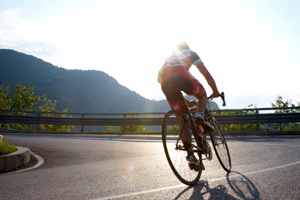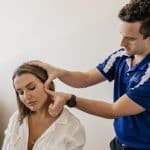5 Reasons why cycling causes neck and shoulder pain, and what you can do about it

If you’re a cyclist, then you’ll know it’s common to get a pain in your neck after a ride, and that it can often happen after even the shortest of trips. If you want to rid yourself of this pain in a way that combines practicality with affordable, non-invasive therapies there are many alternative solutions available, but first it’s helpful to understand why you experience discomfort in the first place.
Here are the most common reasons:
1. Your bike isn’t set up properly
Your neck issues could be caused by your bike’s handles being lower than your seat. Raising them will reduce the impact being placed on the muscles of your neck and shoulders. In time, as your fitness increases, you’ll be able to slowly lower its height.
2. You’re looking the wrong way
Reducing neck pain while cycling could boil down to how you engage a small muscle group near your eyes. Your ocular motor is a group of muscles that work in unison to control your eye movements and help both eyes to track an object as a pair. This is what allows you to seamlessly read words across page or copy something from a blackboard without confusion. It also helps your visual perception which lets you catch and throw objects normally, as well as become generally more aware, discriminating and perceptive in your perception of the space around you.
So what does this have to do with riding a bike?
You see, many riders look up and into the distance too much when riding, which means that their neck stabilisers aren’t working and they compensate by straining their shoulder muscles. The best position for neck stability is slightly tucking your chin and looking directly ahead, which strengthens your ocular motor response, further stabilising your neck and helping to hold the position. Looking ahead also prevents your shoulder blades from getting weak and unstable.
3. You aren’t activating your core
Just because your core is strong, it doesn’t mean you’re all set. When cycling, too many people focus only on strength and not muscular activation, which can potentially cause injury. Unless you’re activating your core muscle groups as you ride, you might experience strain in your shoulder blades and destabilisation in your neck. You can also lean too far forward on your bike’s handlebars, creating further neck tension which in turn creates a tension headache.
4. You aren’t warming up
Gentle neck stretches are important if you’re over 40 years old, have had a neck or whiplash injury in the past, or spend hours in front of a computer every day, as this means you’ll already have a small amount of stiffness and tension present. Gentle stretches that don’t lead to instability on your bike are important. You can also include other gentle mobility movements that target your hips, lumbar/thoracic area, spine and shoulders before getting on your bike. This will make sure that your muscles are activated and that any lingering tightness has been released.
5. You are rotating your head and chatting
It’s important to be able to look out for oncoming traffic, but if you’re doing it too often and for more than a few seconds at a time, it can cause neck problems. It’s common for those who ride two abreast to experience this problem, as they’re constantly turning to chat toeach other. It’s best to avoid this as it can shorten certain muscles on the side of your neck, leading to an asymmetrical body and lower spine problems.
Cycling is a great way to get fit, so don’t let pain get in the way. Follow the practical advice listed above, and if you’re looking for more targeted neck and shoulder pain relief ‘neck and shoulder pain relief’, make regular physiotherapy sessions a part of your post cycling schedule and you’ll be able to bike comfortably for years to come.



